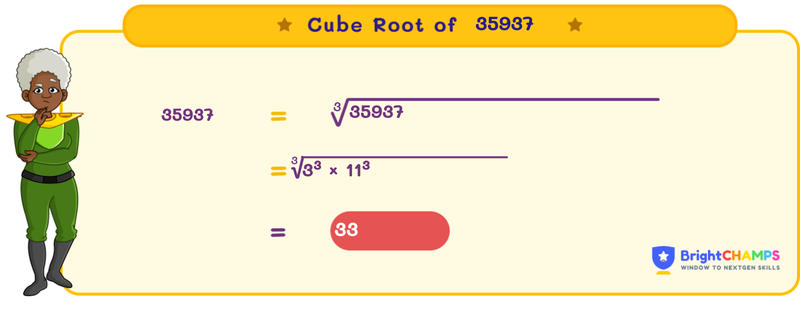Summarize this article:
 295 Learners
295 LearnersLast updated on August 5, 2025
Cube Root of 35937

A number that we multiply by itself three times to get the original number is its cube root. It has various uses in real life, such as finding the volume of cube-shaped objects and designing structures. We will now find the cube root of 35937 and explain the methods used.

What is the Cube Root of 35937?
We have learned the definition of the cube root. Now, let’s learn how it is represented using a symbol and exponent. The symbol we use to express the cube root is the radical sign (∛), and the exponent we use is ⅓.
In exponential form, ∛35937 is written as 35937(1/3). The cube root is just the opposite operation of finding the cube of a number. For example, assume ‘y’ is the cube root of 35937, then y3 can be 35937. Since the cube root of 35937 is an exact value, it is 33.


Finding the Cube Root of 35937
Finding the cube root of a number involves identifying the number that must be multiplied three times to result in the target number. Now, we will go through the different ways to find the cube root of 35937. The common methods we follow to find the cube root are given below:
- Prime factorization method
- Estimation method
- Subtraction method
- Halley’s method
Since 35937 is a perfect cube, we can use the prime factorization method to find its cube root.

Cube Root of 35937 by Prime Factorization
Let's find the cube root of 35937 using the prime factorization method.
First, we factorize 35937 into its prime factors:
35937 = 3 × 3 × 3 × 11 × 11 × 11
Grouping the prime factors into triples, we have:
(3 × 3 × 3) and (11 × 11 × 11)
The cube root is the product of one factor from each group: ∛35937 = 3 × 11 = 33
The cube root of 35937 is 33.
Explore Our Programs



Common Mistakes and How to Avoid Them in the Cube Root of 35937
Finding the cube root of a number without any errors can be a difficult task for students. This happens for many reasons. Here are a few mistakes students commonly make and ways to avoid them:

Cube Root of 35937 Examples:

Problem 1
Imagine you have a cube-shaped toy that has a total volume of 35937 cubic centimeters. Find the length of one side of the cube.

Side of the cube = ∛35937 = 33 units
Explanation
To find the side of the cube, we need to find the cube root of the given volume. Therefore, the side length of the cube is 33 units.

Problem 2
A company manufactures 35937 cubic meters of material. Calculate the amount of material left after using 12000 cubic meters.

The amount of material left is 23937 cubic meters.
Explanation
To find the remaining material, subtract the used material from the total amount:
35937 - 12000 = 23937 cubic meters.

Problem 3
A bottle holds 35937 cubic meters of volume. Another bottle holds a volume of 8000 cubic meters. What would be the total volume if the bottles are combined?

The total volume of the combined bottles is 43937 cubic meters.
Explanation
Explanation: Let’s add the volume of both bottles:
35937 + 8000 = 43937 cubic meters.

Problem 4
When the cube root of 35937 is multiplied by 2, calculate the resultant value. How will this affect the cube of the new value?

2 × 33 = 66 The cube of 66 = 287496
Explanation
When we multiply the cube root of 35937 by 2, it results in a significant increase in volume because the cube increases exponentially.

Problem 5
Find ∛(46000+46000).

∛(46000+46000) = ∛92000 ≈ 44.63
Explanation
As shown in the question ∛(46000+46000), we can simplify that by adding them.
So, 46000 + 46000 = 92000.
Then we use this step: ∛92000 ≈ 44.63 to get the answer.


FAQs on 35937 Cube Root
1.Can we find the Cube Root of 35937?
2.Why is the Cube Root of 35937 not irrational?
3.Is it possible to get the cube root of 35937 as an exact number?
4.Can we find the cube root of any number using prime factorization?
5.Is there any formula to find the cube root of a number?

Important Glossaries for Cube Root of 35937
- Cube root: The number that is multiplied three times by itself to get the given number is the cube root of that number.
- Perfect cube: A number is a perfect cube when it is the product of multiplying a number three times by itself. A perfect cube always results in a whole number. For example: 3 × 3 × 3 = 27, therefore, 27 is a perfect cube.
- Exponent: The exponent form of the number denotes the number of times a number can be multiplied by itself. In a(1/3), ⅓ is the exponent which denotes the cube root of a.
- Radical sign: The symbol that is used to represent a root is expressed as (∛).
- Prime factorization: A method of breaking down a number into its prime factors, which can be useful in determining whether a number is a perfect cube.



Jaskaran Singh Saluja
About the Author
Jaskaran Singh Saluja is a math wizard with nearly three years of experience as a math teacher. His expertise is in algebra, so he can make algebra classes interesting by turning tricky equations into simple puzzles.
Fun Fact
: He loves to play the quiz with kids through algebra to make kids love it.

















